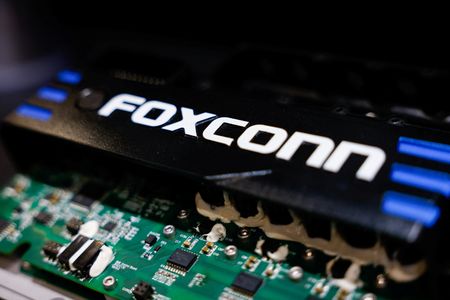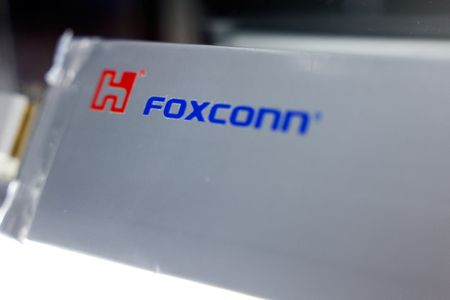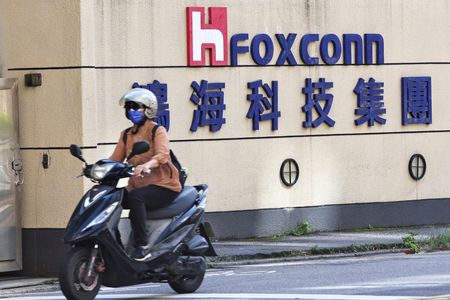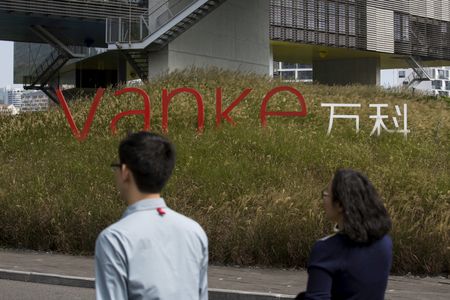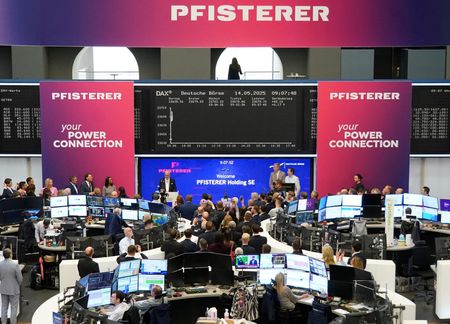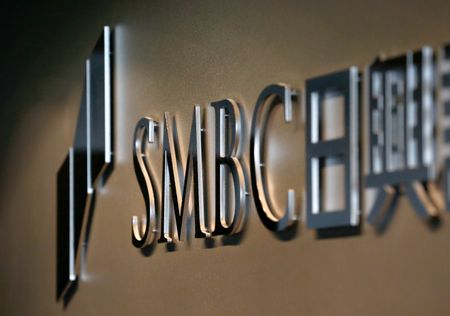By Wen-Yee Lee and Yimou Lee
TAIPEI (Reuters) – Taiwan’s Foxconn, the world’s largest contract electronics maker, downgraded its full-year outlook on Wednesday citing recent appreciation of the Taiwan dollar, even as it struck an upbeat note about booming demand for AI servers.
Foxconn, Apple’s top iPhone assembler and Nvidia’s AI server maker, has ridden the crest of the wave for artificial intelligence demand, but is also vulnerable to changes in U.S. trade and tariff policy given its large manufacturing footprint in countries like China and Mexico.
Chairman Young Liu said on an earnings call that U.S. tariffs will bring more challenges and his outlook for the full year was more cautious than previously, after the company predicted significant growth for 2025 compared with a previous outlook of strong growth.
He said the reason for the change in the outlook was the recent changes in the value of the Taiwan dollar against the greenback, which has risen in value on speculation – denied by Taiwan’s government – that Washington asked Taipei to allow its appreciation as part of tariff talks.
“Because of the exchange rate, it may affect the performance of the revenue amount after conversion into Taiwan dollars. Therefore, compared to March, our outlook for this year is a bit more cautious, so we slightly adjusted our outlook for this year to significant growth,” Liu added.
“Over the past month, rapid changes in U.S. tariff policies have considerably impacted the global supply chain. With recent exchange rate fluctuations adding to the uncertainty, we are taking a more cautious outlook for the near future.”
While Washington and Beijing on Monday agreed to slash tariffs for at least 90 days, the cheer over the temporary truce was tempered by caution given a more permanent trade deal needs to be struck, while higher tariffs overall could still weigh on the global economy.
Most of the iPhones Foxconn makes for Apple are assembled in China. Foxconn is also building a large manufacturing facility in Mexico – another target of U.S. President Donald Trump’s tariffs – to produce AI servers for Nvidia.
Nvidia said in April it would produce AI servers worth $500 billion in the U.S. over four years, working with companies like TSMC and Foxconn in Houston.
In its earnings report, Foxconn said it should see significant on-year growth in the second quarter, with high double-digit growth year-on-year for AI servers and an accelerating volume production ramp-up.
The manufacturer does not provide numerical guidance.
Net profit for January-March jumped an on-year 91% to T$42.12 billion ($1.39 billion), far exceeding the T$37.8 billion average of 13 analyst estimates compiled by LSEG.
Foxconn, formally Hon Hai Precision Industry, last month said January-March revenue jumped 24.2% to a record for that quarter on strong sales of AI servers.
Foxconn has been looking to expand its footprint in electric vehicles, which it sees as a major future growth generator.
Subsidiary Foxtron Vehicle Technologies and Japanese automaker Mitsubishi Motors last week announced the signing of a memorandum of understanding for the supply of an electric vehicle model.
Foxconn has previously said it would consider taking a stake in Nissan for cooperation. Japan’s third-biggest automaker is striving to make its business leaner and more resilient after weak sales in China and its biggest market the U.S.
Liu said there was “of course some progress” in talks with Japanese carmakers, which he did not name, but that he had nothing to announce.
Foxconn’s shares have fallen 11.4% so far this year, hit by concerns about U.S. trade policy, compared with a 5.4% decline for the broader Taiwan index.
They closed up 3.2% on Wednesday ahead of the earnings call.
($1 = 30.2680 Taiwan dollars)
(Reporting by Wen-Yee Lee and Yimou Lee; Writing by Ben Blanchard; Editing by Christopher Cushing and Jan Harvey)

